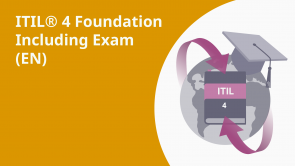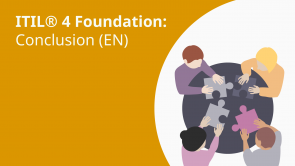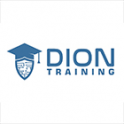ITIL® 4 Foundation: Sample Exam 2

Über den Vortrag
Der Vortrag „ITIL® 4 Foundation: Sample Exam 2“ von Dion Training ist Bestandteil des Kurses „ITIL® 4 Foundation: Conclusion (EN)“.
Quiz zum Vortrag
What is the effect of increased automation on the 'service desk' practice? (Copyright © AXELOS Limited 2019, usage approved by AXELOS Limited. All rights reserved.)
- Greater ability to focus on customer experience when personal contact is needed
- Decrease in self-service incident logging and resolution
- Increased ability to focus on fixing technology instead of supporting people
- Elimination of the need to escalate incidents to support teams
Which term describes the functionality offered by a service? (Copyright © AXELOS Limited 2019, usage approved by AXELOS Limited. All rights reserved.)
- Utility
- Cost
- Warranty
- Risk
Which is the purpose of the 'monitoring and event management' practice? (Copyright © AXELOS Limited 2019, usage approved by AXELOS Limited. All rights reserved.)
- To systematically observe services and service components, and record and report selected changes of state
- To ensure that accurate and reliable information about the configuration of services is available when and where it is needed
- To protect the information needed by the organization to conduct its business
- To minimize the negative impact of incidents by restoring normal service operation as quickly as possible
What should all 'continual improvement' decisions be based on? (Copyright © AXELOS Limited 2019, usage approved by AXELOS Limited. All rights reserved.)
- Accurate and carefully analysed data
- Details of how services are measured
- An up-to-date balanced scorecard
- A recent maturity assessment
How do all value chain activities transform inputs to outputs? (Copyright © AXELOS Limited 2019, usage approved by AXELOS Limited. All rights reserved.)
- By using a combination of practices
- By determining service demand
- By using a single functional team
- By implementing process automation
How does customer engagement contribute to the 'service level management' practice? 1. It captures information that metrics can be based on 2. It ensures the organization meets defined service levels 3. It defines the workflows for service requests 4. It supports progress discussions (Copyright © AXELOS Limited 2019, usage approved by AXELOS Limited. All rights reserved.)
- 1 and 4
- 1 and 2
- 2 and 3
- 3 and 4
What is the starting point for optimization? (Copyright © AXELOS Limited 2019, usage approved by AXELOS Limited. All rights reserved.)
- Understanding the vision and objectives of the organization
- Securing stakeholder engagement
- Determining where the most positive impact would be
- Standardizing practices and services
Identify the missing words in the following sentence. The purpose of the [?] is to ensure that the organization continually co-creates value with all stakeholders in line with the organization's objectives. (Copyright © AXELOS Limited 2019, usage approved by AXELOS Limited. All rights reserved.)
- service value system
- ‘focus on value’ guiding principle
- four dimensions of service management
- ‘service request management’ practice
Which practice provides support for managing feedback, compliments and complaints from users? (Copyright © AXELOS Limited 2019, usage approved by AXELOS Limited. All rights reserved.)
- Service request management
- Change control
- Problem management
- Incident management
Which joint activity performed by a service provider and service consumer ensures continual value co-creation? (Copyright © AXELOS Limited 2019, usage approved by AXELOS Limited. All rights reserved.)
- Service relationship management
- Service provision
- Service consumption
- Service offering
Which practice may involve the initiation of disaster recovery? (Copyright © AXELOS Limited 2019, usage approved by AXELOS Limited. All rights reserved.)
- Incident management
- Service request management
- Service level management
- IT asset management
What type of change is MOST likely to be managed by the 'service request management' practice? (Copyright © AXELOS Limited 2019, usage approved by AXELOS Limited. All rights reserved.)
- A standard change
- A normal change
- An emergency change
- An application change
Which guiding principle emphasizes the need to understand the flow of work in progress, identify bottlenecks, and uncover waste? (Copyright © AXELOS Limited 2019, usage approved by AXELOS Limited. All rights reserved.)
- Collaborate and promote visibility
- Focus on value
- Think and work holistically
- Keep it simple and practical
What is a means of enabling value co-creation by facilitating outcomes that customers want to achieve? (Copyright © AXELOS Limited 2019, usage approved by AXELOS Limited. All rights reserved.)
- A service
- An output
- A practice
- Continual improvement
Which statement about change authorization is CORRECT? (Copyright © AXELOS Limited 2019, usage approved by AXELOS Limited. All rights reserved.)
- A change authority should be assigned to each type of change and change model
- Centralizing change authorization to a single person is the most effective means of authorization
- The authorization of normal changes should be expedited to ensure they can be implemented quickly
- Standard changes are high risk and should be authorized by the highest level of change authority
Which dimension of service management considers governance, management, and communication? (Copyright © AXELOS Limited 2019, usage approved by AXELOS Limited. All rights reserved.)
- Organizations and people
- Information and technology
- Partners and suppliers
- Value streams and processes
Identify the missing word in the following sentence. A known error is a problem that has been [?] and has not been resolved. (Copyright © AXELOS Limited 2019, usage approved by AXELOS Limited. All rights reserved.)
- analysed
- logged
- escalated
- closed
Which statement about known errors and problems is CORRECT? (Copyright © AXELOS Limited 2019, usage approved by AXELOS Limited. All rights reserved.)
- Known error is the status assigned to a problem after it has been analysed
- A known error is the cause of one or more problems
- Known errors cause vulnerabilities, problems cause incidents
- Known errors are managed by technical staff, problems are managed by service management staff
What does the 'service request management' practice depend on for maximum efficiency? (Copyright © AXELOS Limited 2019, usage approved by AXELOS Limited. All rights reserved.)
- Processes and procedures
- Compliments and complaints
- Self-service tools
- Incident management
Which statement about the 'service desk' practice is CORRECT? (Copyright © AXELOS Limited 2019, usage approved by AXELOS Limited. All rights reserved.)
- It needs a practical understanding of the business processes
- It provides a link with stakeholders at strategic and tactical levels
- It carries out change assessment and authorization
- It investigates the cause of incidents
Which practice ensures that accurate and reliable information is available about configuration items and the relationships between them? (Copyright © AXELOS Limited 2019, usage approved by AXELOS Limited. All rights reserved.)
- Service configuration management
- Service desk
- IT asset management
- Monitoring and event management
Which practice has a purpose that includes restoring normal service operation as quickly as possible? (Copyright © AXELOS Limited 2019, usage approved by AXELOS Limited. All rights reserved.)
- Incident management
- Supplier management
- Deployment management
- Problem management
Identify the missing word in the following sentence. A customer is a person who defines the requirements for a service and takes responsibility for the [?] of service consumption. (Copyright © AXELOS Limited 2019, usage approved by AXELOS Limited. All rights reserved.)
- outcomes
- outputs
- costs
- risks
Which guiding principle describes the importance of doing something, instead of spending a long time analysing different options? (Copyright © AXELOS Limited 2019, usage approved by AXELOS Limited. All rights reserved.)
- Progress iteratively with feedback
- Optimize and automate
- Start where you are
- Focus on value
What should be done for every problem? (Copyright © AXELOS Limited 2019, usage approved by AXELOS Limited. All rights reserved.)
- It should be prioritized based on its potential impact and probability
- It should be diagnosed to identify possible solutions
- It should be resolved so that it can be closed
- It should have a workaround to reduce the impact
How should an organization include third-party suppliers in the continual improvement of services? (Copyright © AXELOS Limited 2019, usage approved by AXELOS Limited. All rights reserved.)
- Ensure suppliers include details of their approach to service improvement in contracts
- Require evidence that the supplier uses agile development methods
- Require evidence that the supplier implements all improvements using project management practices
- Ensure that all supplier problem management activities result in improvements
What considerations influence the supplier strategy of an organization? (Copyright © AXELOS Limited 2019, usage approved by AXELOS Limited. All rights reserved.)
- Corporate culture of the organization
- Contracts and agreements
- Type of cooperation with suppliers
- Level of formality
What is a problem? (Copyright © AXELOS Limited 2019, usage approved by AXELOS Limited. All rights reserved.)
- A cause or potential cause of one or more incidents
- An addition or modification that could have an effect on services
- Any change of state that has significance for the management of a configuration item
- An unplanned reduction in the quality of a service
What is the purpose of the 'relationship management' practice? (Copyright © AXELOS Limited 2019, usage approved by AXELOS Limited. All rights reserved.)
- To establish and nurture the links between the organization and its stakeholders at strategic and tactical levels
- To align the organization's practices and services with changing business needs
- To reduce the likelihood and impact of incidents by identifying actual and potential causes of incidents, and managing workarounds and known errors
- To minimize the negative impact of incidents by restoring normal service operation as quickly as possible
Which is intended to help an organization adopt and adapt ITIL guidance? (Copyright © AXELOS Limited 2019, usage approved by AXELOS Limited. All rights reserved.)
- The guiding principles
- The four dimensions of service management
- The service value chain
- Practices
What is an output? (Copyright © AXELOS Limited 2019, usage approved by AXELOS Limited. All rights reserved.)
- Something created by carrying out an activity
- A change of state that has significance for the management of a configuration item
- A possible event that could cause harm or loss
- A result for a stakeholder
What is the reason for using a balanced bundle of service metrics? (Copyright © AXELOS Limited 2019, usage approved by AXELOS Limited. All rights reserved.)
- It provides an outcome-based view of services
- It reduces the number of metrics that need to be collected
- It reports each service element separately
- It facilitates the automatic collection of metrics
Why should incidents be prioritized? (Copyright © AXELOS Limited 2019, usage approved by AXELOS Limited. All rights reserved.)
- To ensure that incidents with the highest business impact are resolved first
- To help automated matching of incidents to problems or known errors
- To identify which support team the incident should be escalated to
- To encourage a high level of collaboration within and between teams
Which practice has a purpose that includes helping the organization to maximize value, control costs and manage risks? (Copyright © AXELOS Limited 2019, usage approved by AXELOS Limited. All rights reserved.)
- IT asset management
- Relationship management
- Release management
- Service desk
Why should service desk staff detect recurring issues? (Copyright © AXELOS Limited 2019, usage approved by AXELOS Limited. All rights reserved.)
- To help identify problems
- To escalate incidents to the correct support team
- To ensure effective handling of service requests
- To engage the correct change authority
Which value chain activity communicates the current status of all four dimensions of service management? (Copyright © AXELOS Limited 2019, usage approved by AXELOS Limited. All rights reserved.)
- Plan
- Improve
- Engage
- Obtain/build
Which guiding principle is PRIMARILY concerned with consumer's revenue and growth? (Copyright © AXELOS Limited 2019, usage approved by AXELOS Limited. All rights reserved.)
- Focus on value
- Keep it simple and practical
- Optimize and automate
- Progress iteratively with feedback
Which practice provides visibility of the organization's services by capturing and reporting on service performance? (Copyright © AXELOS Limited 2019, usage approved by AXELOS Limited. All rights reserved.)
- Service level management
- Service desk
- Service request management
- Service configuration management
Which is the BEST example of an emergency change? (Copyright © AXELOS Limited 2019, usage approved by AXELOS Limited. All rights reserved.)
- The implementation of a security patch to a critical software application
- The implementation of a planned new release of a software application
- A low-risk computer upgrade implemented as a service request
- A scheduled major hardware and software implementation
Which guiding principle recommends assessing the current state and deciding what can be reused? (Copyright © AXELOS Limited 2019, usage approved by AXELOS Limited. All rights reserved.)
- Start where you are
- Focus on value
- Collaborate and promote visibility
- Progress iteratively with feedback
Kundenrezensionen
5,0 von 5 Sternen
| 5 Sterne |
|
5 |
| 4 Sterne |
|
0 |
| 3 Sterne |
|
0 |
| 2 Sterne |
|
0 |
| 1 Stern |
|
0 |




